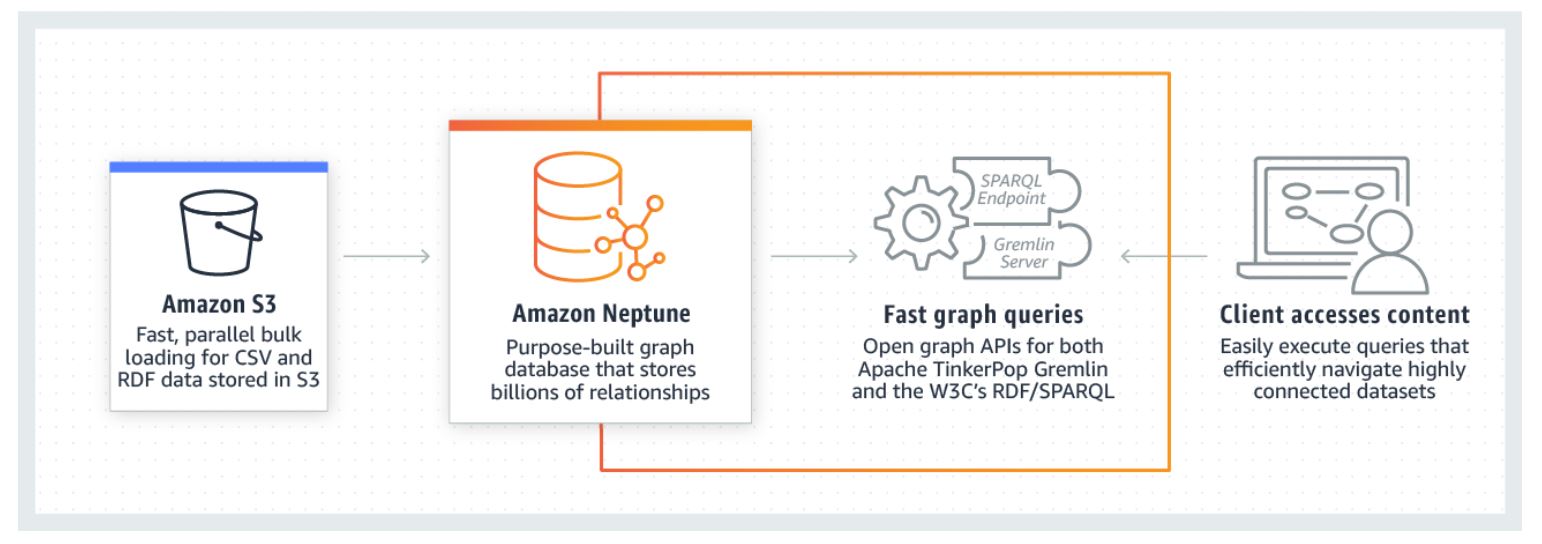- Amazon Neptune is a fully managed graph database service used for building applications that work with highly connected datasets.
- Optimized for storing billions of relationships between pieces of information.
- Provide milliseconds latency when querying the graph.
- Neptune supports graph query languages like Apache TinkerPop Gremlin and W3C’s SPARQL.

- Social Networking
- Amazon Neptune can easily process user’s interactions like comments, follows, and likes in a social network application through highly interactive queries.
- Recommendation Engines
- You can use Amazon Neptune to build applications for suggesting personalized and relevant products based on relationships between information such as customer’s interest and purchase history.
- Knowledge Graphs
- With the help of Amazon Neptune, you can create a knowledge graph for search engines that will enable users to quickly discover new information.
- Identity Graphs
- You can use Amazon Neptune as a graph database to easily link and update user profile data for ad-targeting, personalization, and analytics.
- Supports 15 read replicas and 100,000s of queries per second.
- Amazon Neptune uses query optimization for both SPARQL queries and Gremlin traversals.
- Database volume is replicated six ways across three availability zones.
- Amazon Neptune can withstand a loss of up to two copies of data and three copies of data without affecting write availability and read availability respectively.
- Amazon Neptune’s storage is self-healing. Data blocks are continuously scanned for errors and replaced automatically.
- Amazon Neptune uses asynchronous replication to update the changes made to the primary instance to all of Neptune’s read replicas.
- Replicas can act as a failover target with no data loss.
- Supports automatic failover.
- Supports promotion priority within a cluster. Amazon Neptune will promote the replica with the highest priority tier to primary when the primary instance fails.
Cluster Volume | Local Storage | |
STORED DATA TYPE | Persistent data | Temporary data |
SCALABILITY | Automatically scales out when more space is required | Limited to the DB Instance class |
- Automated backups are always enabled.
- Supports Point-In-Time restoration, which can be up to 5 minutes in the past.
- Supports sharing of encrypted manual snapshots.
- Amazon Neptune supports AWS Key Management Service ( KMS ) encryption at rest.
- It also supports HTTPS connection. Neptune enforces a minimum version of TLS v1.2 and SSL client connections to Neptune in all AWS Regions where Neptune is available.
- To encrypt an existing Neptune instance, you should create a new instance with encryption enabled and migrate your data into it.
- You can create custom endpoints for Amazon Neptune to access your workload. Custom endpoints allow you to distribute your workload across a designated set of instances within a Neptune cluster.
- Offers database deletion protection.
- You are billed based on the DB instance hours, I/O requests, storage, and Data transfer.
- Storage rate and I/O rate is billed in per GB-month increments and per million request increments respectively.
- Visualize your graph using the Neptune Workbench.
- You can receive event notifications on your Amazon Neptune DB clusters, DB instances, DB cluster snapshots, parameter groups, or security groups through Amazon SNS.
- It does not support cross-region replicas.
- Encryption of an existing Neptune instance is not supported.
- Sharing of automatic DB snapshots to other accounts is not allowed. A workaround for this is to manually copy the snapshot from the automatic snapshot, then, copy the manual snapshot to another account.

No comments:
Post a Comment